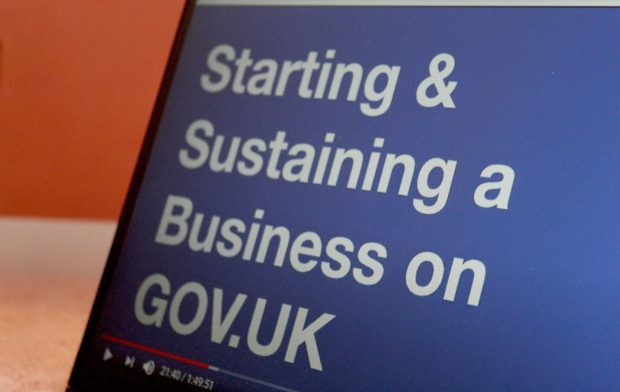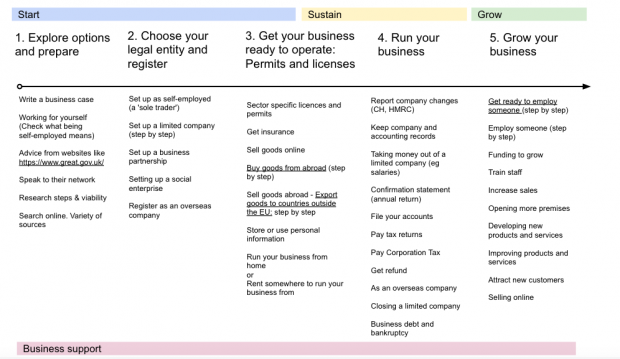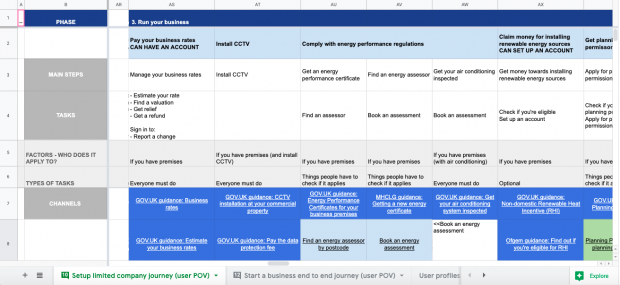
At GOV.UK, we believe users shouldn’t have to understand how government works to find out what they need to do. We want to make it simpler for people to navigate the complexity of government.
This isn’t a new priority for the Government Digital Service (GDS), but it remains an important one.
The way government is structured with different departments means that sometimes complex interactions that people need to have are not as joined-up as they should be. This can affect both a user’s journey and the outcome of their visit to GOV.UK.
We describe these complex areas as “whole user journeys”. They’re usually related to a life event like having a child, contain multiple services, or involve steps that the user needs to take between distinct transactions over a period of time. Whole user journeys involve many departments, some of which own the policy area, and some of which own the delivery of services within that area.
One example of a whole user journey is starting and sustaining a business. It’s a complex interaction that cuts across more than 10 different departments. We wanted to see how GOV.UK could support businesses by joining up departments’ efforts on this journey.
This blog post describes how we approached scoping our work in this vast service area. We will shortly be publishing a second blog post on the lessons learned from our work.
Initial scoping and mapping the service landscape
In my role as a Service Designer on GOV.UK I started by zooming out and trying to understand the space. I started doing this by developing a high-level overview of the existing content, which gave me a clear picture of what starting, sustaining and growing a business looks like, and what stages there were.
I did this by dividing the information on GOV.UK into these high-level stages:
- Explore options and prepare
- Choose your legal entity and register
- Get your business ready to operate
- Run your business
- Grow your business
The diagram below shows these stages in a linear fashion; however, this is not how they appear on GOV.UK.

It became clear that the first 2 stages were a more straightforward journey. For example, it included registering as a limited company which is already set up as a step by step navigation.
However, after registering, the journey became more complicated. What to do after registering depends on the business sector, industry, location, and so on. This means people had to find and navigate multiple pages of information and figure out what was relevant to them.
Once we’d done the high-level overview, we then decided to map the service landscape on GOV.UK in more detail in an audit. This captured all the content, transactional services and tasks users can find on GOV.UK when starting a business.
With the help of Crispin Fu, a user researcher on GOV.UK, we started by reviewing the existing content on GOV.UK’s setting up a business browse page and the step by step guide to setting up a limited company. The 2 images below show what we noted and the spreadsheet they were added to.


This helped show what government provides today under “start a business”, and which departments are involved.
We created this map so that we had:
- a shared understanding of the process of starting a business
- a starting point to identity key pages to measure using Google Analytics
- an idea of which departments we need to reach out in order to make improvements and collaborate
So, our initial steps were zooming out to see the wider picture, and then zooming in to understand what content, services, channels and departments are involved. This work helped the team and stakeholders appreciate the breadth of this journey.
Tackling the complicated journeys in ‘sustaining a business’
Once we had reviewed the initial stage of starting a business, we decided to look further into the user journey to better understand where the opportunities for improvement were.
According to our user research, users have less awareness of what they need after they’ve registered their company. This stage was much more challenging to scope, as it was less linear.
To approach scoping here, Lorna Howes, a user researcher on GOV.UK, and I:
- collected information about what we already knew about users
- did an initial review of related content on GOV.UK to identify key verbs and actions under “running” and “growing” a business
- proposed different ways in which we could look at the information (for example, different user modes/mindsets such as “business as usual” or “I need help”)
- proposed user journeys (for example, to focus on the importing/exporting user journey or a user journey based on a specific business sector such as the food sector)
We ran a session with a team to share our findings and decided as a team to focus on:
- limited companies in their first one to two years of trading
- tasks that all limited companies have to do in order to run and grow their business, regardless of their sector or industry: things like filing tax returns
We also wanted to spot opportunities to reuse publicly available data that users have entered before in their journey. For example, when a user sets up a limited company with Companies House they could be provided with content and services on GOV.UK relevant to their sector, to encourage people to take the most appropriate actions. We’ve blogged about our work in using data to visualise and map the journeys in this space too.
Developing a prototype
We’re using our scoping work and user research to develop a prototype to make it clearer to users what they need to do and when. This means people are less likely to miss important regulations or opportunities for support.
We’ll be blogging more about our work and the prototype soon. If you want to find out more, I presented a summary of our work at the Services Week Open Show and Tell (starts at 21:20).
In the next few weeks, we’ll be publishing an accompanying blog post on the lessons we learned from this approach. Please subscribe to the blog to be notified when it’s published.
Read the second part to this blog post here: Five lessons from how we approached scoping a whole user journey
GOV.UK is hiring throughout 2021 to 2022! Find out more on our GDS careers page or read our 4 tips when applying for a job at GOV.UK blog post.
 The GOV.UK app went live in public beta in July 2025. Find out what’s been happening, and what’s coming next,
The GOV.UK app went live in public beta in July 2025. Find out what’s been happening, and what’s coming next,
3 comments
Comment by Vikram posted on
Interesting stuff. What was the purpose of collecting the verbs?
Comment by Ignacia Orellana posted on
Hi,
After we looked at starting a business, we wanted to explore what happens next. We were trying to define what we meant by “sustaining a business”. For this, we needed to drill down a bit further and understand the differences of “running” and “growing” a business. One way we did this was by reviewing the content and services on GOV.UK in these areas, and looking at the verbs (or actions) associated with them. For example we saw actions like “pay your taxes”, “report something is wrong” or “claim for a refund”, as different from “increasing your sales”, “developing” and “improving”. This helped us define the concepts and better scope where we should focus our work.
Thanks, Ignacia
Comment by Vikram posted on
Interesting, thanks.